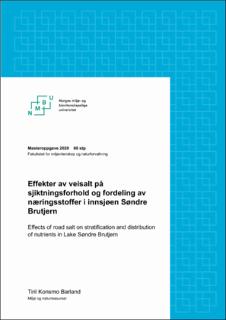| dc.contributor.advisor | Riise, Gunnhild | |
| dc.contributor.advisor | Rohrlack, Thomas | |
| dc.contributor.advisor | Sørlie, Lene Heier | |
| dc.contributor.advisor | Kronvall, Kjersti Jeanette Wike | |
| dc.contributor.author | Barland, Tiril Konsmo | |
| dc.coverage.spatial | Norway, Østfold, Ørje | en_US |
| dc.date.accessioned | 2020-08-07T12:36:19Z | |
| dc.date.available | 2020-08-07T12:36:19Z | |
| dc.date.issued | 2020 | |
| dc.identifier.uri | https://hdl.handle.net/11250/2671225 | |
| dc.description.abstract | Veisalt anvendes som avisningsmiddel på veier om vinteren for å forhindre at snø og is fryser på veibanen. Saltholdig avrenningsvann fra veioverflater kan medføre forringelse av økologisk og kjemisk tilstand i mottagende resipienter. Dersom det akkumuleres saltholdig (ionerikt) bunnvann i en innsjø kan det dannes en permanent kjemisk tetthetsgradient mot øvre vannlag. Tetthetsgradienten hindrer vertikal blanding av vannmassene og påvirker dermed vannkvaliteten med påfølgende effekter på biota. Denne studien undersøkte påvirkningen fra veisaltavrenning på en humøs innsjø (Søndre Brutjern) i Viken. Innsjøen har tidligere blitt klassifisert som sterkt påvirket av veisalt grunnet avrenning fra FV128 (tidligere E18), med tydelig kloridgradient samt anoksiske forhold i bunnvannet.
Målet med denne studien var å avklare (1) sjiktningsforholdene i innsjøen, og (2) om permanent kjemisk sjiktning har medført akkumulering av næringsstoffene fosfat og ammonium i bunnvannet. Undersøkelsene ble utført i perioden januar til august 2019. Det ble gjennomført kontinuerlig logging av temperatur og konduktivitet, samt vannprøvetaking og in situ målinger i hele vannsøylen ved det dypeste punktet i det søndre innsjøbassenget. | en_US |
| dc.description.abstract | Road salt is used as a de-icing agent on roads in winter to prevent snow and ice from setting. Saline runoff water from road surfaces can cause deterioration of ecological and chemical status in receiving recipients. If saline (ion-rich) water accumulates at the bottom of a lake, a permanent chemical density gradient towards the upper water layer can be formed. The density gradient prevents vertical mixing of the water masses and thus affects the water quality with subsequent effects on biota. This study investigated the impact of road salt runoff on a humic lake (Søndre Brutjern) located in southeast Norway. The lake has previously been classified as strongly influenced by road salt due to runoff from FV128 (former E18), with a clear chloride gradient as well as persistent anoxic conditions in the bottom waters.
The aim of this study was to (1) determine the lake stratification regime, and (2) decide whether permanent chemical stratification have caused accumulation of the nutrients phosphate and ammonium in the bottom waters. The surveys were conducted during the period January to August 2019. Continuous logging of temperature and conductivity, as well as water sampling and in situ measurements throughout the water column, were carried out at the deepest point in the southern lake pool. | en_US |
| dc.description.sponsorship | Statens vegvesen | en_US |
| dc.language.iso | nob | en_US |
| dc.publisher | Norwegian University of Life Sciences, Ås | en_US |
| dc.rights | Navngivelse 4.0 Internasjonal | * |
| dc.rights.uri | http://creativecommons.org/licenses/by/4.0/deed.no | * |
| dc.title | Effekter av veisalt på sjiktningsforhold og fordeling av næringsstoffer i innsjøen Søndre Brutjern | en_US |
| dc.title.alternative | Effects of road salt on stratification and distribution of nutrients in Lake Søndre Brutjern | en_US |
| dc.type | Master thesis | en_US |
| dc.description.version | submittedVersion | en_US |
| dc.subject.nsi | VDP::Matematikk og Naturvitenskap: 400::Kjemi: 440::Miljøkjemi, naturmiljøkjemi: 446 | en_US |
| dc.source.pagenumber | 101 | en_US |
| dc.description.localcode | M-MINA | en_US |

